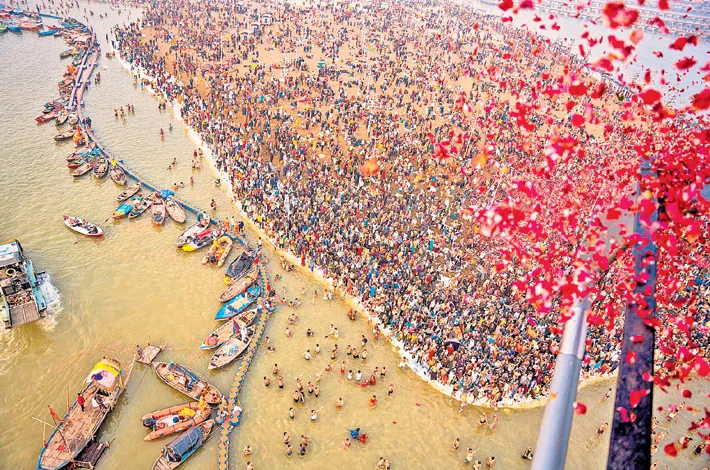Mahakumbh, a gathering rooted in the ancient Puranas
28-01-2025 12:10:58 AM

The Mahakumbh, a gathering rooted in ancient Puranas, embodies the timeless essence of Sanatan Dharma, uniting millions in a shared journey of faith, devotion, and spiritual awakening. According to ancient Puranic lore, a celestial battle between gods and demons led to the emergence of amrit, the nectar of immortality, at four sacred locations: Prayagraj, Haridwar, Ujjain, and Nashik.
These sites, celebrated through the grand Kumbh Melas, are spiritual epicenters where humanity reconnects with the divine. The Mahakumbh represents the eternal struggle between good and evil, cooperation and conflict, and symbolizes the quest for immortality.
Adi Shankaracharya's journey across India, from Kalady to Kedarnath, sought to unify the diverse spiritual traditions of Bharat, weaving them into a single tapestry of shared heritage and faith. This vision of cultural and spiritual unity finds its most striking expression at the Mahakumbh.
For generations, devotees from across India have journeyed to the Ganga, carrying sacred waters from various rivers to symbolize the interconnectedness of India's spiritual and cultural life. As Prime Minister Modi has aptly observed, the Mahakumbh is not merely an Indian event; it is a testament to the world's shared spiritual essence.
The rivers of India, from the mighty Ganga to the tranquil Krishna and Kaveri, are carriers of Sanatan Dharma's enduring values. They embody the ethos of a civilization that celebrates nature, seeks harmony, and accepts diversity. Despite differences in language, customs, and cuisine, the foundational practices of Sanatan Dharma remain universal across regions.
The Mahakumbh stands as the ultimate celebration of this shared heritage, where seekers and saints, pilgrims and wanderers, come together to reaffirm the idea that while paths may vary, the ultimate destination is a shared connection with the divine and with one another.
In his 118th 'Mann Ki Baat' address, Prime Minister Narendra Modi highlighted the Mahakumbh as an extraordinary confluence of equality and harmony, emphasizing its role in celebrating unity in diversity. People from all over India and the world gather at the Sangam, transcending social divisions, and participating together in rituals and community feasts.
The Mahakumbh has evolved into a global model of harmony between tradition and modern environmental practices. The event has embraced sustainability in ways that the world can learn from, such as creating a plastic-free environment, promoting biodegradable alternatives, and implementing efficient waste management systems.
The event's commitment to environmental stewardship extends to its green initiatives, including the planting of over three lakh saplings to increase urban greenery. The “One Bag, One Thali” campaign distributes reusable steel plates and cloth bags to devotees, further underscoring the focus on waste reduction and sustainable living.
By involving volunteers in these initiatives, the Mahakumbh fosters community participation, making sustainability a collective responsibility. The Mahakumbh is not just a spiritual gathering, but a reflection of India's deep-rooted values—values that have withstood the test of time and continue to inspire the world today.
The world can look to India, not only for its cultural and spiritual wisdom but for the example it sets in harmonizing its past with its future. This is India's moment to shine, to show that pride in our roots can lead to a flourishing future, grounded in sustainability and unity.
As we celebrate the Mahakumbh, we must recognize its significance as a global model of spiritual unity and sustainability. We must strive to preserve and promote our cultural heritage, while embracing modern practices that prioritize environmental stewardship. By doing so, we can ensure a brighter future for generations to come.
-Tulla Veerender Goud Official spokesperson for BJP








